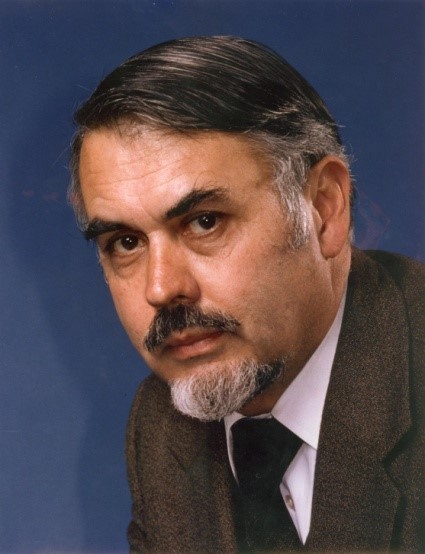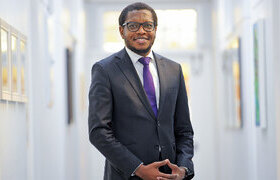Jacquez Charl ‘Kay’ de Villiers: 1928–2018
05 June 2018
It is with great sadness we share the news of the passing of a much-admired and deeply respected member of our faculty, Emeritus Professor Jacquez Charl “Kay” de Villiers, polymath, historian, teacher, leader and neurosurgeon, on Tuesday, 5 June 2018.
Born in Klerksdorp in the Western Transvaal on 7 March 1928, Kay matriculated in 1945 as a bright and engaging scholar, having already acquired his lifelong nickname. Mentorship by his history teacher nurtured a love for all matters historical but after being told by his guidance teacher he could do anything, he decided to study Medicine- and at the University of Cape Town at the insistence of his father who had been born in Paarl. Following graduation and internship at Groote Schuur Hospital, he commenced general practice in Swellendam for four years before taking up a lecturer post in Anatomy in 1957 at the newly established University of Stellenbosch Medical School, as a prelude to the FRCS exam and surgical training in London in 1960.
He spoke often of his time in Swellendam, where many of his clinical skills were honed, together with uncanny diagnostic acumen. Encountering a family where five generations had suffered from polycystic kidney disease, he started researching this, culminating in an MD thesis on the genetics of this condition. He later imparted his love of general practice, conveyed with such a persuasive array of amusing anecdotes to generations of medical students at UCT that many graduated firmly convinced this was a necessary precursor to a happy and successful specialist career!
Kay spent five invigorating years in the UK, undergoing neurosurgical training at the National Hospital for Nervous Diseases, Queen Square and Atkinson Morley’s Hospital, Wimbledon. During this time he was mentored by Mr Wylie McKissock, doyen of British neurosurgery and another source of endless anecdotes. Training in neurosurgery before the advent of the CT scanner was brutal and relentless but he found time to immerse himself in history, literature and poetry, and excelled academically, winning a research fellowship to spend a year studying head injury in the laboratory of Dr Tom Langfitt in Philadelphia.
Upon his return to South Africa in 1966, Kay was appointed as the first full-time neurosurgeon at Groote Schuur Hospital, and devoted the remainder of his career to this institution. He duly followed De Villiers Hamman as Head of Department in 1972 and was honoured as the first incumbent of the Helen and Morris Mauerberger Chair of Neurosurgery.
While his research interests were those of any dedicated clinician, reflecting the diversity of conditions he encountered in his daily practice, he made special contributions to the understanding of head injury in children, in work done with the young Dr Marian Jacobs. Prof de Villiers was the face of Neurosurgery in South Africa, pioneering new techniques through time spent in Zurich, Charlottesville and Paris- the latter allowing him to bring back the new technique of trans-sphenoidal pituitary surgery- and an appreciation of fine cognac which never waned and enlivened visits to his home.
He led Neurosurgery at UCT for 22 years during which time the clinical service moved from its first home in J Block to the New Main Building. With his close friend Roland Eastman he dreamed of one day seeing an institute for neuroscience at Groote Schuur Hospital- which is now under construction.
Prof de Villiers’ contributions extended beyond the hospital, making an enormous impact on Medicine and Higher Education in South Africa. His decisive leadership found him serving as president or chair of several learned organisations including the Society of Neurosurgeons of South Africa, and is the only South African elected an Honorary President of the World Federation of Neurosurgical Societies. A highlight was his tenure as Chair of Council of the University of the Western Cape in the 1980s, where his talent for annoying the political establishment was rewarded with an Honorary DSc in 1989.
While his love of clinical neurology knew no bounds, his over-arching passion was history. A Wellcome Foundation travelling fellowship in 1998 enabled him to research medical aspects of the Anglo-Boer War, which led to numerous publications and culminated in his magnum opus Healers, Helpers and Hospitals: A history of Military Medicine in the Anglo-Boer war, winner of the UCT Book Award in 2011. He was determined to bring history to life and devoted his retirement to establishing the Cape Medical Museum which established the annual Kay de Villiers lecture in his honour, most recently given by Professor Bongani Mayosi.
Prof de Villiers was a polymath who could truly be called a Renaissance Man. His breadth of knowledge and depth of understanding was magisterial but never over-bearing, modulated by an impish sense of humour, especially in his later years. His memory for the patients he cared for, and the small details that made all the difference in their lives was just breath-taking, and inspired us all to be more attentive doctors. His legendary teaching skills earned him one of the first Distinguished Teacher Awards and along the way he mentored many fine neurosurgeons, including his successor Professor Jonathan C Peter, who all made their mark yet retained a strong loyalty to the department.
He was devoted to his first wife, the artistic and courageous Kina who died shortly after his return from the UK in 1966, and endured again the great sadness of losing his wife when his beloved Jeanne (affectionately regarded at Red Cross Children’s Hospital through her work at the Poisons Centre) died in 2016. Our thoughts are with their children Charl and Elfrida, and their families. His memory will live on in them, in the generations he inspired, the many colleagues who knew and admired him, and the institutions he cherished.
 This work is licensed under a Creative Commons Attribution-NoDerivatives 4.0 International License.
This work is licensed under a Creative Commons Attribution-NoDerivatives 4.0 International License.
Please view the republishing articles page for more information.









